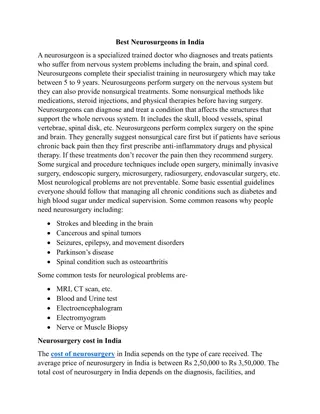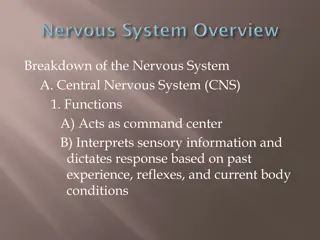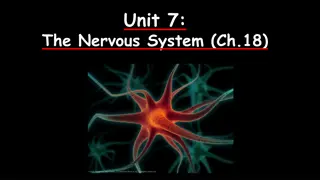Central Nervous System Neuropathology Practical Session
In this neuropathology practical session led by Dr. Shaesta Naseem, various topics such as normal anatomy, histology, CNS cells, selected CNS diseases, and a clinical case study are covered. The session includes images illustrating structures like the cerebrum, cerebellum, brain stem, meninges, and gross findings of diseases such as meningioma. Participants learn to diagnose conditions based on imaging and clinical information like in the case of a 43-year-old female with a parietal region mass causing seizures.
Download Presentation

Please find below an Image/Link to download the presentation.
The content on the website is provided AS IS for your information and personal use only. It may not be sold, licensed, or shared on other websites without obtaining consent from the author.If you encounter any issues during the download, it is possible that the publisher has removed the file from their server.
You are allowed to download the files provided on this website for personal or commercial use, subject to the condition that they are used lawfully. All files are the property of their respective owners.
The content on the website is provided AS IS for your information and personal use only. It may not be sold, licensed, or shared on other websites without obtaining consent from the author.
E N D
Presentation Transcript
CLASSROOM MANAGEMENT 432 Introduction Developed by Dr. Mustafa Altun mustafa.altun@ishik.edu.iq
EFFECTIVE SEATING ARRANGEMENT In some schools teachers deliberately ask students to sit in specific seats for whole class work, such as listening to the teacher explaining something. This arrangement may be:
Alphabetical order of surname or first name. Age or height. Recent test scores. Gender (all the boys on one side, all the girls on the other; or girl/boy, girl/boy). Good and naughty (the naughtier you are, the closer you are to the front).
However, very commonly students simply stay wherever they sat down when they came in the room (which, in a multilingual class, might often mean all of one nationality I language group clumped together).
What these ways don't do is creatively match up people for specific reasons, such as those who might work well together or who might support each other. The techniques in this unit suggest some ways that the teacher can arrange people within the whole class. (For making arrangements useful when working in pairs and groups)
Of course, if left to choose for themselves, many students will always sit in the same place every lesson. Most of us do it when we enter a classroom. Some seats feel comfortable, safer, more suitable, more like 'ours'. Even experienced teachers who briefly return to the student role on refresher training courses find that they quickly establish their own place in a room.
When we are the teacher with a class of students, we have to decide how much we go with the natural unfolding of things or how much we intervene to reshape the room and events to achieve what we hope will be a better result. Learners might well show reluctance or unhappiness at being asked to change to a different place, but it's worth taking the risk.
Part of the job of teaching is helping people discover things that they didn't know they wanted. When students meet and talk with new people, there may be surprising new learning. The extra effort and initial discomfort may be more than counterbalanced by other pleasant and surprising results.
Of course, some seating layouts may prove not to work at all. As a teacher you need to remain alert to genuine unhappiness, people who simply do not get on together and groupings that do not gel.
ORGANISING LEARNERS IN DIFFERENT WAYS Here are some ideas for organizing learners in different ways for different purposes. All of these require the teacher to proactively make the organization happen. This may be at the beginning of class or at one or more points later in the lesson.
1. Mixed nationalities I language groups 2. Language support 3. Differentiated learning 4. Friendships 5.Learner-planned seating 6. ???
Mixed nationalities I language groups You may decide to deliberately place students from different language groups next to each other - or more importantly, make sure that learners who speak the same language do not sit together.
Language support You can sit stronger students next to weaker ones in order that the former can help the latter. This can work well for short periods of time, but may be unfairly demanding on the stronger student if done over a long time and could be embarrassing for the weaker student.
Differentiated learning Contrastingly, you can group learners by language level- sitting stronger students next to each other and weaker students together. This allows you to offer different tasks, or variations on the same task, to different students. Make sure that any differentiated arrangement you make does not visibly separate or pick out the weaker students in any way that could be embarrassing or uncomfortable.
Friendships The 'wherever they sat when they came into the room' arrangement very often reflects friendships, but is also typically quite random - people sit wherever there is a remaining space. You may want to engineer things a little more, deliberately placing people that you know like each other close together.
Learner-planned seating Ask your learners to plan who sits where. This task could be done in groups where each group has a blank plan of the desks and seats. Each group's arrangement could then be used for a lesson (or a week)- and then the next group s plan and so on. You will need to check that there is no deliberate unkindness involved, e.g. placing students who don't like each other together. You may want to allow some time (e.g. after the lesson) when students can feed back to you if they are uncomfortable with any future lesson s seating plan.
Getting students quickly into the right places How are students organised in your class? Do you allow them to sit wherever they choose to?
1. Mixed nationalities I language groups 2. Language support 3. Differentiated learning 4. Friendships 5.Learner-planned seating Which of the ideas for organizing your class appeal most to you?
This is an efficient way of getting students to quickly sit in the place you want them to be in. Draw a plan showing classroom seat positions. Photocopy it a few times for future use and different classes. On one copy, write the names of the students on each desk, indicating where they should sit. Pin this up on the wall outside the room or just inside the door. Train your students to look at this plan as they arrive and go straight to their seat. It will be chaos the first time you try it, but persevere - it gets better when they have done it a few times.
In many movies, cartoons and photos of classrooms, the teacher is typically to be found standing center stage at the front of the room, face-to-face with the students. This is the classic teacher position, for fairly obvious reasons: the teacher can make eye contact with everyone; all students can see him or her clearly; the teacher can make announcements and give instructions with ease. In traditional education, the teacher might well have stayed in this location through whole lessons, days and courses, perhaps even with the addition of a desk as added protection from students.
In our more active, more interactive, more democratic classrooms, we can usefully challenge the assumption that the front is the default, best or only place for a teacher to be.
Why shouldn't instructions be given from anywhere in the room? Why should the teacher be restricted to only one or two places?
There are many reasons why you might want to play around a little with where you stand in class:
To explore how being in different positions changes the way the class works: Do students understand instructions and tasks any better? To experiment with working alongside students rather than watching them from in front. To challenge student assumptions about your role in class. By not being at the front, you subtly start to reduce expectations that you are always 'in charge'. You send the message that you are not always about to make an announcement or give an explanation. To see how being in different places changes your own feelings about what it means to be a teacher. Do you feel any closer to your students? Do you feel less in charge? More involved? More or less comfortable generally?
Different teacher positions 1. If your classroom chairs are arranged in a semicircle, sit mid semicircle, as part of the group, rather than in a separate seat at the front. 2. If your class has fixed desks in rows, make one desk (perhaps towards the back of the room) your base for a lesson. Keep coming back to this place rather than to the front of the room. (NB such an arrangement may not be viable in a culture where students would feel they were being rude to have their back to the teacher.) 3 .Give instructions from different locations at the side or back of the room. 4 . Try clearing a space mid-room, and use this to give instructions. (Yes. you will need to keep turning around to make eye contact with people in different parts of the room!) 5. Have a whole lesson during which you deliberately avoid the front of the room, e.g. never sitting down at the front of the class.
If so, make sure that they can see your lips when you speak to give instructions or explanations. A window or light source behind you can make this much more difficult as you might appear in silhouette.
SHARING CLASSROOMS I'd love to create a special English environment in a classroom, but I don't have one room . I teach all over the school, sharing rooms with other teachers
To create good classroom environments even though you have to move from room to room.
But what if you have to share the classroom with your colleagues?
Here are some ideas for possible agreements: 1 Allocated wall space 2 Allocated storage space 3 Separate corners 4 Seat-arrangement rotas
1 Allocated wall space Agree that the notice board and any usable wal1 space be fairly divided. It may be that some teachers inform you that they don't actually need their part.
2 Allocated storage space Divide up the available storage space (drawers, cupboard space, shelf space) so that each teacher has their own area. Use your allocation to store useful boxed materials that you can quickly take out at the start of each lesson to create an instant English class room without too much fuss. This could include dictionaries, a box of readers that students can borrow, a selection of magazines, your vocabulary box, flashcards, a wall poster or two, a phonemic chart to stick to the board and so on.
3 Separate corners If you have the Iuxury of any free space in the room, you could propose that each corner is reserved for a different teacher or subject. Thus, you might have an English corner, a geography corner and so on. Place a table in this space, and even if the area is small, aim to make good use of it, by putting out picture displays, books, magazines and so on.
4 Seat-arrangement rotas It may be that one teacher really wants the room to be in a certain arrangement (perhaps a traditional one of rows), while you or other language teachers may feel that they want a layout more suitable for interaction and tasks.























